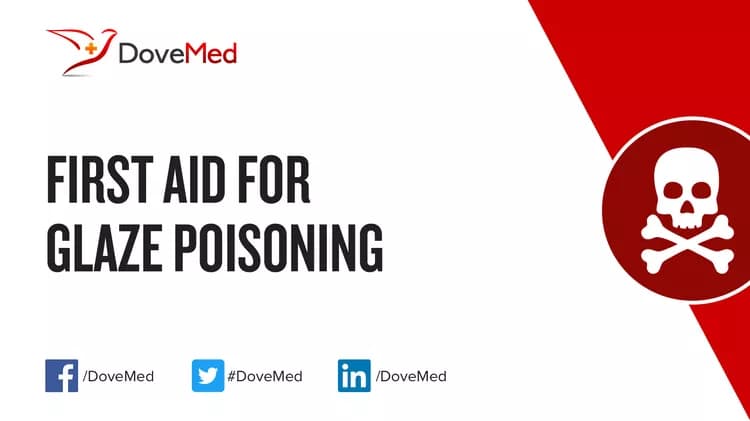What is Glaze Poisoning?
- Glaze refers to surface coatings and paints that are applied to various products including cooking utensils, pans, pottery, and ceramic wares
- Generally, glazing used for kitchen utensils belong to a non-toxic grade and consumption in small quantities are not harmful
- Glaze Poisoning is the accidental or intentional intake of any product containing the compound. The exposure may be through ingestion (long-term) of the chemical substance
- The condition is diagnosed based upon the clinical history, combination of signs and symptoms, and additional tests (that may include, in some cases, radiological studies and laboratory tests)
Glaze Poisoning may be also referred to as Glaze Toxicity.
What are the Causes of Glaze Poisoning?
- Glaze Poisoning is caused by the chronic ingestion of glaze
- This intake could be accidental, or in some cases intentional, to bring self-harm
- Even though commercially-used glaze is considered non-toxic, some of the chemicals present in them include heavy metals, such as lead, cadmium, nickel, selenium, and cobalt, certain inorganic compounds, and hydrocarbons
Note: The compound can interact with other prescribed or non-prescribed medications in the body. Such interactions may enhance the therapeutic effects of other medications being taken, resulting in undesired side effects.
What are the Signs and Symptoms of Glaze Poisoning?
The signs and symptoms of Glaze Poisoning can vary from one individual to another. It may be mild in some and severe in others. Several systems of the body may be affected. The symptoms are generally observed following long-term and chronic ingestion.
The signs and symptoms of Glaze Poisoning may include:
- Appetite loss; unexplained weight loss
- Vomiting
- Constipation or diarrhea
- Different taste in the mouth (metallic taste); feeling thirsty
- Headache and fatigue; weakness
- Muscle aches and joint pain; muscle twitching
- Vision abnormalities; hearing loss
- Urination difficulties
- Yellowing of skin and eyes (jaundice); pale skin
- Increased or decreased blood pressure (hypertension or hypotension)
- Feeling confused, over-excitement or feeling disinterested
- Hallucinations
- Lack of coordinated movements, walking difficulties
- Renal damage and failure
- Seizures and tremors (shaking)
- Paralysis and coma
How is First Aid administered for Glaze Poisoning?
First Aid tips for Glaze Poisoning:
- Call 911 or your local emergency help number immediately, for emergency assistance
- Call the Poison Control Center at 1-800-222-1222 (or your local poison control center) for further instructions
- Provide them with information such as the compound taken, quantity and time of ingestion, age, weight and general health status of affected individual
- Confirm that the airways are protected; also, ensure breathing and the presence of pulse
- If skin exposure or involvement of the eye has occurred, then wash thoroughly with copious amounts of water (for at least 15 minutes)
- Unless instructed by a healthcare professional, DO NOT induce vomiting in the affected individual
- Take individual to emergency room (ER) for further treatment
- Always try to take the compound bottle/container to the ER
The emergency medical health professional might perform the following steps towards treating the condition:
- Medically manage symptoms, such as abnormal heart rate and seizures
- Provide breathing support, if necessary
- Gastric lavage for elimination of the substance from the stomach (irrigation using special solutions)
- Administer activated charcoal to avoid absorbance of the substance in the body
- Administer suitable medication to counter the effects of the substance
- Wash skin and eyes repeatedly and thoroughly (irrigation), to eliminate any remaining hazardous compound
- Following this, a suitable skin or eye ointment may be used to treat the exposure
- Administer fluids by an intravenous drip line
Who should administer First Aid for Glaze Poisoning?
First aid for Glaze Poisoning is administered by healthcare professionals.
- The individual who is affected, or someone near, should call 911 for emergency assistance (or the local emergency number)
- They should also call the poison control center at 1-800-222-1222 (or the local poison control center) and follow instructions
What is the Prognosis of Glaze Poisoning?
- The prognosis of Glaze Poisoning is dependent on the type and amount of substance consumed, time between consumption and treatment, severity of the symptoms, as well as general health status of the patient
- If the individual can recover from the symptoms, with appropriate medication and early support, the outcome is generally good. In most cases, the prognosis is good
- However, severe poisoning can result in serious complications and the prognosis can be ascertained only on a case-by-case basis. It has been observed that internal injury may continue to take place for many weeks following the swallowing incident
In general, toxicities are common situations in the emergency departments. A majority of the cases are often not fatal, when appropriate treatment is given.
How can Glaze Poisoning be Prevented?
Glaze Poisoning can be prevented by:
- Always following instructions for usage of any health, cosmetic, or household products
- Keeping any poisonous/hazardous chemicals and other materials out of children’s reach
- Keep all poisons correctly labeled and in suitable storage locations
- Being aware of basic first aid steps in case of an emergency (such as inadvertent poisoning)
What are certain Crucial Steps to be followed?
- Call 911 (or your local emergency number) for emergency assistance, if symptoms are life-threatening
- Call Poison Control Center at 1-800-222-1222 (or the local poison control center) and follow the recommend steps
- It would be helpful if the following information is readily available:
- Type, amount and time of consumption of the substance
- Age and weight of the individual
- And, the overall health status of the individual
Related Articles
Test Your Knowledge
Asked by users
Related Centers
Related Specialties
Related Physicians
Related Procedures
Related Resources
Join DoveHubs
and connect with fellow professionals


0 Comments
Please log in to post a comment.